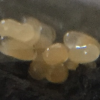We have a beginning colony of pogonomyrmex badius housed in a hearth from Tarheel Ants. This is our first experience in trying to raise ants, so forgive me if I leave any crucial information out or use incorrect terminology.
Our formicarium is kept on a table in our carport outdoors to keep temperatures similar to what the ants would naturally encounter. Our queen was caught on June 29 and the first nanitic worker emerged on September 1. We added a number of different seeds to the outworld, and the queen and nanitic both have come up and hauled them into the nest. The problem is that they don't seem to be discarding them again, and now some have grown furry yellow mold, particularly one that is resting on the screen above the water compartment.
I had thought the ants would do their own maintenance, and am now wondering if it is worth the disruption to open the glass and remove these contaminated seeds? Will the ants eventually take care of it on their own?
If we do need to remove the seeds, is there any way to make it less traumatic to the ants (and avoid being stung!)? Like maybe cooling the nest first?
- Formiculture.com
- Forums
- Gallery
- Members
- Member Map
- Chat
















